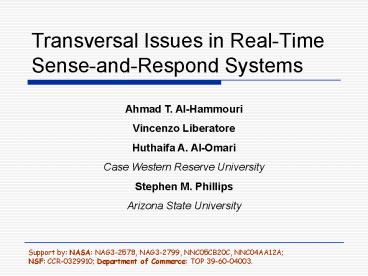Transversal Issues in Real-Time Sense-and-Respond Systems
Title:
Transversal Issues in Real-Time Sense-and-Respond Systems
Description:
Arizona State University ... Use of system models: predict a future state. Jitter ... Achieve fair bandwidth allocation between different flows. Example ... –
Number of Views:21
Avg rating:3.0/5.0
Title: Transversal Issues in Real-Time Sense-and-Respond Systems
1
Transversal Issues in Real-Time Sense-and-Respond
Systems
Ahmad T. Al-Hammouri Vincenzo Liberatore Huthaifa
A. Al-Omari Case Western Reserve
University Stephen M. Phillips Arizona State
University Support by NASA NAG3-2578,
NAG3-2799, NNC05CB20C, NNC04AA12A
NSF CCR-0329910 Department of Commerce TOP
39-60-04003.
2
Real-Time SR
- Objective
- Tele-epistemological vision
- Networked SR extend human reach beyond spatial
barriers - Remote control of physical environment by sense
and respond - Potential Applications
- Industrial automation
- Automatic asset mgmt. (RFID)
- Disaster Recovery
- UAVs LNK03
- Home robotics
3
Our contributions
- Formulate Real-Time SR for Networks research
- Middleware demonstration
- Playback buffers
- Congestion control
- Work in-progress
- Multihoming, implementation, etc.
4
(No Transcript)
5
Real-Time SR and Networks
- Real-Time SR involve the physical environments
- Real-Time objectives and constraints
- Real-time objectives
- Correctness, reliability, and safety
- Flexibility, scalability, and efficiency
- Communication networks
- No timeliness or QoS guarantees BW limitation,
losses, delays, and jitter - Focus has been on
- Control theory, real-time systems, middleware,
and data bases
6
Main thesis
- Networks research is critical for Real-Time SR
- Playback buffers
- Congestion control
- Quality-of-Service
- Major technology gap
- Multimedia streaming, anyone?
7
Transversal issues
- SR control environments
- Radically differ in complexity and in
applications - Include hierarchical levels of abstraction
- Transversal issues
- Address the necessity of providing QoS for SR
- These are
- Adaptability and tolerance
- Congestion control
- Security, fault tolerance, etc.
8
Transversal issues
- We are currently involved in _at_ Case
- Adaptability and tolerance
- Congestion control
9
Adaptability and tolerance
- SR systems must be adaptable to
- Delays
- Jitter
10
Adaptability and tolerance (cont.)
- .di s vary randomly
- Decompose di as di t ?i
- .t the nominal round-trip delay (predictable
across i) - .?i the variation (jitter) in every round-trip
time delay - Two subproblems
- Predictable delays
- Jitter
11
Adaptability and tolerance (cont.)
- Predictable delays (?i 0, di t)
- Methods to mitigate predictable delays
- Sacrificing performance to preserve stability,
e.g., robots teleoperation - Use of system models predict a future state
- Jitter
- Jitter causes inaccurate predictions in
delay-compensation techniques - Playback buffers can eliminate jitter
12
Playback buffers
Packet
Sequence number
generation
Adapted from Peterson Davie
T
ime
13
Playback buffers multimedia vs. SR
- Different performance metrics
- Round-trip delay jitter
- Playback delays are determined by controller
- Controller is away from the host that applies the
signal - Controller needs RTT to detect a delay spike
VoIP stream
14
Our contribution
- Combined strategies of playback, control laws,
and adaptive sampling - Controller determines playback delay based on RTT
samples - Adaptive playback delay
- Based on the playback delay, Controller
determines - control signal, and
- sampling rate
15
Transversal issues
- We are currently involved in _at_ Case
- Adaptability and tolerance
- Congestion control
16
Congestion control
- Match sources transmission rates to network
capacity - Achieve fair bandwidth allocation between
different flows - Example
- S1 r1, r2, r3 0.5, 1.5, 0.5
- S2 r1, r2, r3 0.25, 1.75, 0.75
- S3 r1, r2, r3 0.0, 2.0, 1.0
17
Congestion control (cont.)
- Define a Utility function, Ui(ri)
- Performance of system i transmitting at rate ri
- Mathematical formulation
- max S U(ri)
- s.t. S ri Cl , l 1,, L
- and ri rmin,i
18
Congestion control (cont.)
queuen
Sink
Source
19
Our contribution
- Choice of a utility function, Ui(Ai, ri)
- Function of speed of physical dynamics, Ai
- Monotonically increasing and strictly concave
with ri - Tailoring the general optimization
framework for SR
20
Additional directions
- Implement these methods
- Middleware vs. lower-level layers
- Exploit transport layer protocols
- SCTP Multihoming and reliability to SR
- Power management control
21
Thank you
- Comments
- Questions































